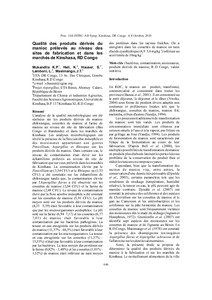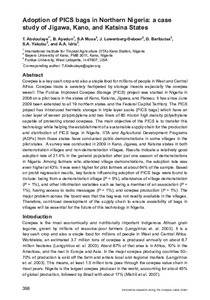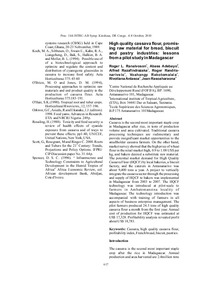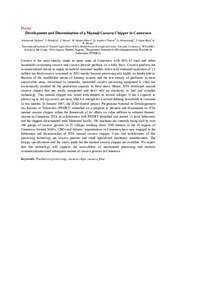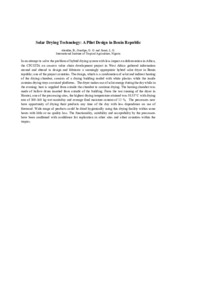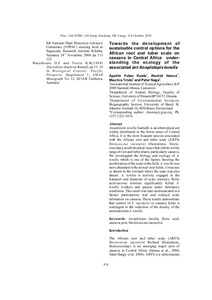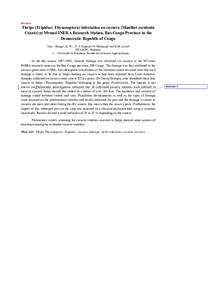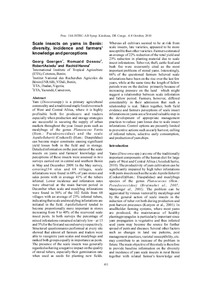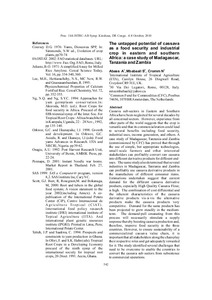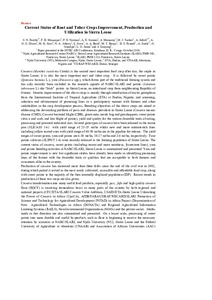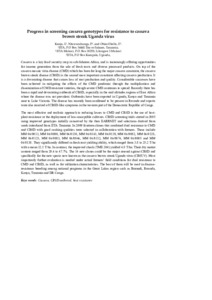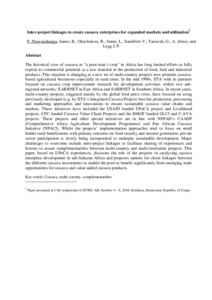Welcome to the International Institute of Tropical Agriculture Research Repository
Conference Documents: Recent submissions
Now showing items 561-580 of 597
-
Improving the productivity of cowpea in the savannas of northeast Nigeria through participatory evaluation and dissemination of improved varieties
(International Institute of Tropical Agriculture, 2012)Cowpea is a major food and cash crop in northern Nigeria, providing nutritious grain and a less expensive source of protein for both the rural poor and urban consumers. A number of improved varieties have been developed combining diverse plant type, and different maturity periods, with resistance or tolerance to several diseases, insect pests, and parasitic weeds and possessing other good agronomic traits. Despite this, farmers in northeast Nigeria have continued to grow predominantly local ... -
The influence and implications of climate change and variability on Coffea arabica in the East African highlands: Mt. Kilimanjaro case study
(Association for Science and Information on Coffee, 2012)The coffee growing regions on the slopes of Mt. Kilimanjaro have become progressively warmer and drier over the past 48 years. The minimum temperature is the predominant climatic variable which influences coffee yields over longer-term climatic change. In contrast, the amounts of rainfall and in particular the timing of rainfall at specific growth periods are the most important climatic variables governing coffee yields on the micro-climatic scale. The predicted increase in climate change (temperature) ... -
Qualité des produits dérivés du manioc prélevés au niveau des sites de fabrication et dans les marchés de Kinshasa, RD Congo
(International Association of Hydrological Sciences, 2012-02)L'analyse de la qualité microbiologique ont été réalisées sur les produits dérivés du manioc chikwangue, cossettes de manioc et farine de manioc au niveau du site de fabrication (Bas Congo et Bandundu) et dans les marchés de Kinshasa. Les analyses microbiologiques ont révélé la présence de la flore aérobie mésophile et des moisissures appartenant aux genres Penicillium, Aspergillus et Rhizopus sur les produits dérivés du manioc. Dans certains cas, le niveau de contamination était élevé sur ... -
Adoption of PICS bags in Northern Nigeria: a case study of Jigawa, Kano, and Katsina States
(International Institute of Tropical Agriculture, 2012)Cowpea is a key cash crop and also a staple food for millions of people in West and Central Africa. Cowpea trade is severely hampered by storage insects especially the cowpea weevil. The Purdue Improved Cowpea Storage (PICS) project was started in Nigeria in 2008 on a pilot basis in the states of Kano, Katsina, Jigawa, and Plateau. It has since June 2009 been extended to all 19 northern states and the Federal Capital Territory. The PICS project has introduced hermetic storage in triple layer sacks ... -
High quality cassava flour, promising raw material for bread, biscuit and pastry industries: lessons from a pilot study in Madagascar
(International Society For Tropical Root Crops-Africa Branch, 2012-02)Cassava is the second most important staple crop in Madagascar after rice, in term of production volume and area cultivated. Traditional cassava processing techniques are rudimentary and provide insignificant market opportunities to the smallholder cassava farmers. On the other hand, market survey showed that the high price of wheat flour in the retail market high, 0.9 to 1.08 US$ per kg, and bakers desired a substitute raw material. The potential market demand for High Quality Cassava Flour (HQCF) ... -
Adding value to Africa's cassava in a global environment
(International Association of Hydrological Sciences, 2012-02)Based on experiences in the Cassava: Adding Value for Africa (C:AVA) project, this paper examines emerging issues and lessons for adding value to cassava, one of Africa's widely cultivated staples in ways that contribute to the global market environment as well as bring benefits to small holders on the continent. The main issues discussed include: competiveness in the supply of raw material, assisting smallholders to produce value-added products sustainably and competitively, ensuring and maintaining ... -
Effects of fermentation length and varieties on the pasting properties of sour cassava starch
(International Society For Tropical Root Crops-Africa Branch, 2012-02)The effects of length of fermentation (5, 10, 15, 20 and 25 days) on pasting properties of sour starches produced from six cassava varieties were investigated. There were significant differences (p< 0.05) in pasting properties except pasting temperature and breakdown irrespective of the days of fermentation. Peak viscosity ranged from 308.50 to 466.63 RVA, trough ranged from 67.25 to 198.75 RVA, break down ranged from 147.71 to 320.25 RVA, final viscosity ranged from 100.29 to 233.00 RVA, set back ... -
New approaches for quantifying carotenoids content in cassava roots
(International Society For Tropical Root Crops-Africa Branch, 2012-02)Cassava is an ideal vehicle for delivering provitamin A carotenoids to human populations affected by deficiency of this important micronutrient. Rapid cycling recurrent selection has proven to be very effective increasing carotenoids levels in cassava. The maximum level of total carotenoids increased by about 3 μg / g of fresh root each year. As breeding populations evolve large populations are developed and the selection among them becomes increasingly difficult because most genotypes show intense ... -
Proximate composition and physical properties of steamed sour cassava starch bread
(International Association of Hydrological Sciences, 2012-02)The effects of steaming (10min, 20min and 30min) on the properties of sour cassava starch bread were evaluated. Properties examined include pH, moisture content, protein, ash, starch, sugar, amylose content and sensory analysis. Amylose content ranged between (14.04-15.73%), Amylopectin ranged between (84.27-85.96 %), protein content ranged between (3.85-4.18%), Starch and Sugar content ranged between (68.07- 69.01%) and (10.12-10.34%) respectively. As the level of steaming increases the fat ... -
Development and dissemination of a manual cassava chipper in Cameroon
(International Association of Hydrological Sciences, 2012-02)Cassava (Manihot esculenta Crantz) is the main starchy staple in many parts of Cameroon, with 80% of rural and urban households consuming cassava and cassava derived products on a daily basis. Cassava products are commercialized mostly to supply household consumer markets with a total estimated equivalent of 1.1 million ton fresh cassava consumed in 2002 mainly because processing rely highly on family labour. Because of the smallholder nature of farming systems and the low density of producers in ... -
Solar drying technology: a pilot design in Benin Republic
(International Association of Hydrological Sciences, 2012-02)An appropriate drying system remains a critical factor for the development of cassava enterprises in Africa, most especially at the rural sector. As part of solving this problem, the Cassava value chain development in West Africa - a project sponsored by the Common Fund for Commodities source information on existing solar drying systems in Nigeria, Ghana, Uganda, Cameroon, and Sierra Leone. Findings from the survey assisted in the design and fabrication of an hybrid solar drying system with less ... -
Towards the development of sustainable control options for the African root and tuber scale on cassava in Central Africa understanding the ecology of the associated ant Anoplolepis tenella
(International Society For Tropical Root Crops-Africa Branch, 2012-02)Anoplolepis tenella Santschi is an afrotropical ant widely distributed in the forest zones of Central Africa. It is the most frequent species associated with the African root and tuber scale (ARTS) Stictococcus vayssierei (Hemiptera: Stictococcidae), an afrotropical insect that infests a wide range of root and tuber plants, particularly cassava. We investigated the biology and ecology of A. tenella which is one of the factors favoring the proliferation of the scale in the field. A. tenella was ... -
Thrips (Tripidae; Thysanoptera) infestation on cassava (Manihot esculenta Crantz) at Mvuazi INERA research station, Bas-Congo Province in the Democratic Republic of Congo
(International Association of Hydrological Sciences, 2012-02)In the dry season 1997-1998, unusual damage was observed on cassava at M'vuazi INERA research station (Lat. 5°25'S, Long. 14°54'E, Alt. 465m asl) in the Bas-Congo province, DR Congo (DRC). The damage was first attributed to cassava green mite (CGM), but subsequent observations and literature search revealed later that such damage is likely to be due to thrips feeding on cassava. Thrips on cassava had been reported from Latin America. Samples collected on cassava in DRC were sent to IITA curator, ... -
Scale insects on yams in Benin: diversity, incidence and farmers' knowledge and perceptions
(International Association of Hydrological Sciences, 2012-02)Yam (Dioscoreaspp.) is a primary agricultural commodity and a traditional staple food over much of West and Central Africa, where it is highly profitable both for producers and traders especially when production and storage strategies are successful in securing the supply of urban markets throughout the year. Insect pests such as mealybugs of the genus Planococcus Ferris (Hem.: Pseudococcidae) and the scale Aspidiellahartii (Cockerell) (Hem.: Diaspididae) can become major constrains causing ... -
The untapped potential of cassava as a food security and industrial crop in eastern and southern Africa: a case study of Madagascar, Tanzania and Zambia
(International Society For Tropical Root Crops-Africa Branch, 2012-02)Cassava sub-sectors in Eastern and Southern Africa have been neglected for several decades by all concerned sectors. However, experience from other parts of the world suggests that the crop is versatile and that its commercialization could lead to several benefits including food security, industrial uses, income generation, and others. A case study of Madagascar, Tanzania and Zambia (commissioned by CFC) has proved that through the use of simple, but appropriate technologies, small-scale farmers ... -
Cassava value chain development in West Africa: success stories
(International Association of Hydrological Sciences, 2012-02)The initiative of cassava value chain in West Africa has provided sustainable opportunity for transferring best bet agronomic, processing and marketing practices to less privileged small holder enterprises in Nigeria, Benin and Sierra Leone. This project which started 2008, sponsored by Common Fund for Commodities, supervised by FAO and implemented by IITA has been an avenue to improve key players of cassava enterprise in the selected countries to boost their output qualitatively and quantitatively. ... -
Current status of root and tuber crops improvement, production and utilization in Sierra Leone
(International Association of Hydrological Sciences, 2012-02)Cassava (Manihot esculenta Crantz) is the second most important food crop after rice, the staple in Sierra Leone; it is also the most important root and tuber crop. It is followed by sweet potato (Ipomoea batatas L.), yam (Dioscorea spp.), which forms part of the traditional farming system and has only recently been included in the research agenda of NARC/SLARI and potato (Solanum tuberosum L) aka “Irish” potato in Sierra Leone, an introduced crop from neighbouring Republic of Guinea. Genetic ... -
Progress in screening cassava genotypes for resistance to cassava brown streak Uganda virus
(International Association of Hydrological Sciences, 2012-02)Cassava is a key food security crop in sub-Saharan Africa, and is increasingly offering opportunities for income generation from the sale of fresh roots, cuttings and diverse processed products. The total fresh root production is increasingly constrained, by the two principal biotic constraints; cassava mosaic disease (CMD) and cassava brown streak disease (CBSD). Considerable successes have been achieved in mitigating the effects of the CMD pandemic through the multiplication and dissemination ... -
Inter-project linkages to create cassava enterprises for expanded markets and utilization
(The International Society For Tropical Root Crops-Africa Branch, 2012-02)The historical view of cassava as “a poor man crop” in Africa has long limited efforts to fully exploit its commercial potential as raw material in the production of food, feed and industrial products. This situation is now changing, led by special projects which promote cassava-based agric businesses for rural development. In mid 1990s, IITA with its partners focused on cassava crop improvement research for development activities within two sub-regional networks EARRNET in East Africa and SARRNET ... -
Safeguarding good health of consumers: the opportunities and challenges of attaining quality compliance for processed cassava products in Africa
(International Society for Tropical Root Crops Africa Branch, 2012-02)In Sub-Saharan Africa, cassava is mainly grown by smallholder farmers who also process the storage roots into traditional food products. However, improper processing techniques combined with climate variability aggravate risks of health hazards caused by residual toxic cyanogens and mycotoxin contamination of the food products. The introduction of improved processing technologies for the production of a diverse range of cassava-based food and industrial products has enhanced the crop's acceptance ...



